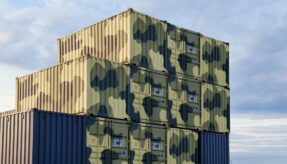
Regulatory compliance and document management are crucial in the aerospace and defence industries. Defence features writer Mark Lane asks Design Rule’s Bob Hillier about how product lifecycle management software can help.
Both aerospace and defence have come a long way since the early generation of gliders first took to the skies more than a century ago. On average nowadays, more than eight million people fly on commercial airliners every day and over 50 million tonnes of cargo is transported by air each year.
Aerospace is one of the most demanding and competitive industries in the world. To keep up with the market pressures, manufacturers have to ensure everything they do – from product design and testing to document management and compliance procedures – is exact.
At the same time, the UK’s defence industry recorded a £200 million growth in turnover in 2015, compared to the previous year. With employee numbers and exports rising, manufacturers in the sector are looking for a way to manage product development, cut time to market and optimise product performance while avoiding unexpected costs.
To meet these challenges, original equipment manufacturers (OEMs) are relying on global partners to maximise product development and product expertise. As teams spread out across different locations, managing a project becomes more complicated and brings new challenges.
This is where Bob Hillier, Managing Director of Design Rule, a supplier of product lifecycle management (PLM) software, believes software solutions have a role to play.
He explains: “Product lifecycle management allows businesses to manage customer requirements and ensure they are all met in the agreed time frame. It also means manufacturers can shorten development cycles by removing the need for paper-based approval systems and streamlining collaboration between global teams.
“The clear advantages of PLM software are widely understood: improved product quality; lower development costs; valuable design data; and a significant reduction in waste.”
But, he argues that another benefit which does not attract as much attention is PLM’s support of regulatory compliance and its ability to retain confidential data.
He notes that one of the main concerns for manufacturing companies in the defence sector is the possibility of data ending up in the wrong hands. Fines for the accidental release of data can be extremely costly and the long-term impact can be hugely damaging.
On the other hand, product development teams need to be able to share relevant data with other departments and authorised users or the product development process becomes slow and inefficient.
He adds: “A unique source of truth also reduces the likelihood of errors and ensures a project is completed correctly and efficiently the first time around. To solve the problem of confidential data protection, manufacturers can implement a PLM platform that imposes rule-based control on the type of data each user can access.”
Surely, the aerospace and defence industry is well informed about its regulatory standards and requirements. Why would companies in the sector need software to help them meet these requirements?
“Nobody would dispute the necessity of regulatory compliance, but in the product development realm it certainly isn’t the most interesting topic. Regardless of its lack of glamour, failure to comply with industry regulations can render the more exciting advantages of PLM redundant.
“From a product designer’s perspective, compliance through PLM delivers notable strategic advantages. Achieving compliance in the initial design stage can save time and reduce engineering changes in the long run. What is more, this design-for-compliance approach sets the bar for quality product development, creating a unified standard to which the entire workforce can adhere.”
He goes on to argue that the support of a PLM platform significantly simplifies the compliance process, especially for businesses operating in sectors with fast-changing or complicated regulations. He points out that the defence industry has its own standards to follow. ITAR (International Traffic in Arms Regulations) and EAR (Export Administration Regulations) are notoriously strict exporting standards, delivering both civil and criminal penalties to companies that fail to comply.
How then can aerospace and defence manufacturers choose the right software to support their compliance?
He says: “Despite varying requirements across industries, there are a number of PLM options that support compliance on an industry-specific basis. Dassault Systèmes’ ENOVIA platform, for example, allows businesses to input compliance definition directly into the program. This ensures that, depending on the industry, the product is able to meet the necessary standards. As an intelligent PLM platform, ENOVIA delivers full traceability of the product development process, from conception right through to manufacturing.
“For those in charge of managing compliance, access to this data is incredibly valuable, both for auditing and for providing evidence to regulatory panels. By acquiring industry-specific modules, businesses can rest assured that their compliance is being managed appropriately for their sector – avoiding nasty surprises or unsuccessful compliance.”
Moreover he believes that the data management capabilities of PLM software can help aerospace and defence manufacturers in areas beyond regulatory compliance.
“Companies that operate in onerous environments have very strict design, test and compliance requirements,” he says. “When these spread across a large team based in different locations, document control can become a bit of a nightmare. Add years’ worth of historical data and drawings to the mix and the situation becomes even more delicate.”
He cites the example of one client: Meggitt, a global engineering group specialising in extreme environment products and sub-systems for the defence, aerospace and energy markets which came to Design Rule for advice on the right software for a better document control system and to get teams based in different locations to collaborate more effectively using a shared platform.
Design Rule helped the group to implement the ENOVIA software platform in Meggitt UK’s offices.
The move to a new software platform also gave Meggitt an opportunity to review and improve its existing document archive. The company had more than a million drawings and documents, some of which dated from the first half of the last century.
Most of these documents had digital copies but most of that was organised in a folder structure similar to the Windows model and shared on the network, while the search function was unreliable.
Meggitt hopes to get more departments and divisions to use the ENOVIA software, turning it into one of the main communication and management tools of the company.
It also plans to move beyond document management and employ PLM for project management and bill of materials management, while also integrating a collaborative CAD software platform into the system.
If you would like to join our community and read more articles like this then please click here







